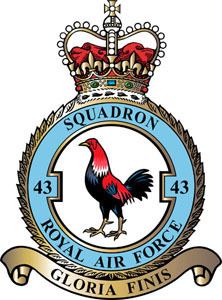Nickname(s) 'The Fighting Cocks' | ||
 | ||
Active 15 April 1916 – 31 December 19191 July 1925 – 16 May 19471 February 1949 – 7 November 19671 September 1969 – 13 July 2009 Motto(s) Latin: Gloria finis("Glory is the end") Battle honours Western Front 1917–1918*, Arras, Ypres 1917*, Cambrai 1917, Somme 1918*, Lys, Amiens, Dunkirk*, Battle of Britain 1940*, Home defence 1940–1942, Fortress Europe 1942, Dieppe, North Africa 1942–1943*, Sicily 1943, Salerno, Italy 1943–1945, Anzio and Nettuno*, Gustav Line, France and Germany 1944*, Gulf 1991, Iraq 2003.Honours marked with an asterisk* are emblazoned on the Squadron Standard | ||
No. 43 Squadron was a Royal Air Force aircraft squadron originally formed in 1916 as part of the Royal Flying Corps. It saw distinguished service during two world wars, producing numerous "aces". The squadron last operated the Panavia Tornado F3 from RAF Leuchars, Scotland, in the air defence role, until it was disbanded in July 2009.
Contents
World War I
The squadron was formed at Stirling on 15 April 1916, from No. 18 Reserve Squadron as a unit of the Royal Flying Corps, and was equipped with various types, which it used for training until December 1916 when Sopwith 1½ Strutters arrived. These were taken to the Western Front the following month, where it operated as an Army squadron carrying out fighter reconnaissance duties.
In September 1917, Sopwith Camels arrived, and the squadron undertook ground attack duties; the squadron continued in this vein until the end of the war. The squadron received Sopwith Snipe in August 1918 and conversion was completed in October, but the Armistice prevented these playing a major part in the conflict, instead they were taken to Germany for occupation duties until August 1919 when the squadron moved to RAF Spitalgate where it disbanded on 31 December 1919. During the course of the war, ten aces served in the squadron, including Henry Woollett, Cecil Frederick King, John Lightfoot Trollope, Geoffrey Bailey, Harold Balfour, Charles C. Banks, Hector Daniel, George Lingham, and John Womersley. ( Robert Johnstone Owen).
Between the wars
The squadron was re-formed at RAF Henlow on 1 July 1925, (or 1 July 1923), once again equipped with Snipes. In 1926, the squadron converted to Gamecocks, thus inspiring the squadron badge and the nickname "The Fighting Cocks". The black and white checkered markings also date from this era. The squadron flew Siskins from 1928 and received the first production Hawker Fury Mk.I in May 1931.
World War II
Prior to the outbreak of World War II the squadron re-equipped with Hurricanes, and it was with these aircraft that the squadron covered the Dunkirk retreat and fought in the Battle of Britain. In November 1942, 43 Squadron moved to North Africa, now flying Spitfires.
In 1944, as the tide of war turned in favour of the Allies, the squadron moved to France, where it was known by the local French population as "les coqs Anglais". By then the squadron's main role was ground attack, strafing and occasionally dive bombing enemy targets. On 9 September 1944, Wing Commander Barrie Heath, flying Spitfire IX MJ628, led a formation on the squadron's first sortie into German territory, strafing motor transport and railway communications.
The squadron ended the war in Austria and was disbanded in 1947.
Entering the jet age
In February 1949, No. 266 Squadron was renumbered to No. 43 Squadron, flying Gloster Meteors from RAF Tangmere. The squadron moved to RAF Leuchars in 1950 and in 1954 began to receive the Hawker Hunter. The Hunters of 43 Squadron featured in the 1957 film High Flight.
During much of the 1960s the squadron operated from Aden and was disbanded on 7 November 1967. 43 Squadron reformed at Leuchars on 1 September 1969 with the McDonnell Douglas Phantom, which it flew until its replacement by the Tornado F.3 in September 1989.
The Tornado Years
With the F3 the squadron participated in the 1991 Gulf War and maintained a presence in the Iraqi no-fly zones. Later, 43 Sqn crew and personnel were tasked with Quick Reaction Alert duty (short notice air defence 'scrambles'), both in Fife, and in the Falklands as part of 1435 Flight and participated in Operation Telic. When the squadron was not on operational taskings they flew daily training sorties through the week, all year round.
The squadron was awarded the "Freedom of the city" of Stirling in 2005, the squadron being Stirling's home squadron in the past.
In April 2008, the squadron absorbed 56 (Reserve) Squadron to perform the role of Tornado F3 Operational Conversion Unit, 56 Squadron having reformed in the ISTAR role. The squadron flagship, ZG757, had a gloss black spine and tail and 90th anniversary emblem on the tail.
Disbandment
No. 43F Sqn stood down on 13 July 2009 for the fourth time in its history. The Squadron Standard, presented in person by HM The Queen at RAF Leuchars on 4 June 1957, was laid up on Sunday 22 May 2016 in the Church of the Holy Rude, Stirling. The 43 Squadron Standard, emblazoned with a black gamecock badge on a field of sky blue and surrounded with the following honours: Western Front 1917–1918, Ypres 1917, Somme 1918, Dunkirk, Battle of Britain 1940, North Africa 1942–1943, Anzio and Nettuno, and France and Germany 1944, will reside in the SE aisle of the Church of the Holy Rude forever. Gloria finis.
